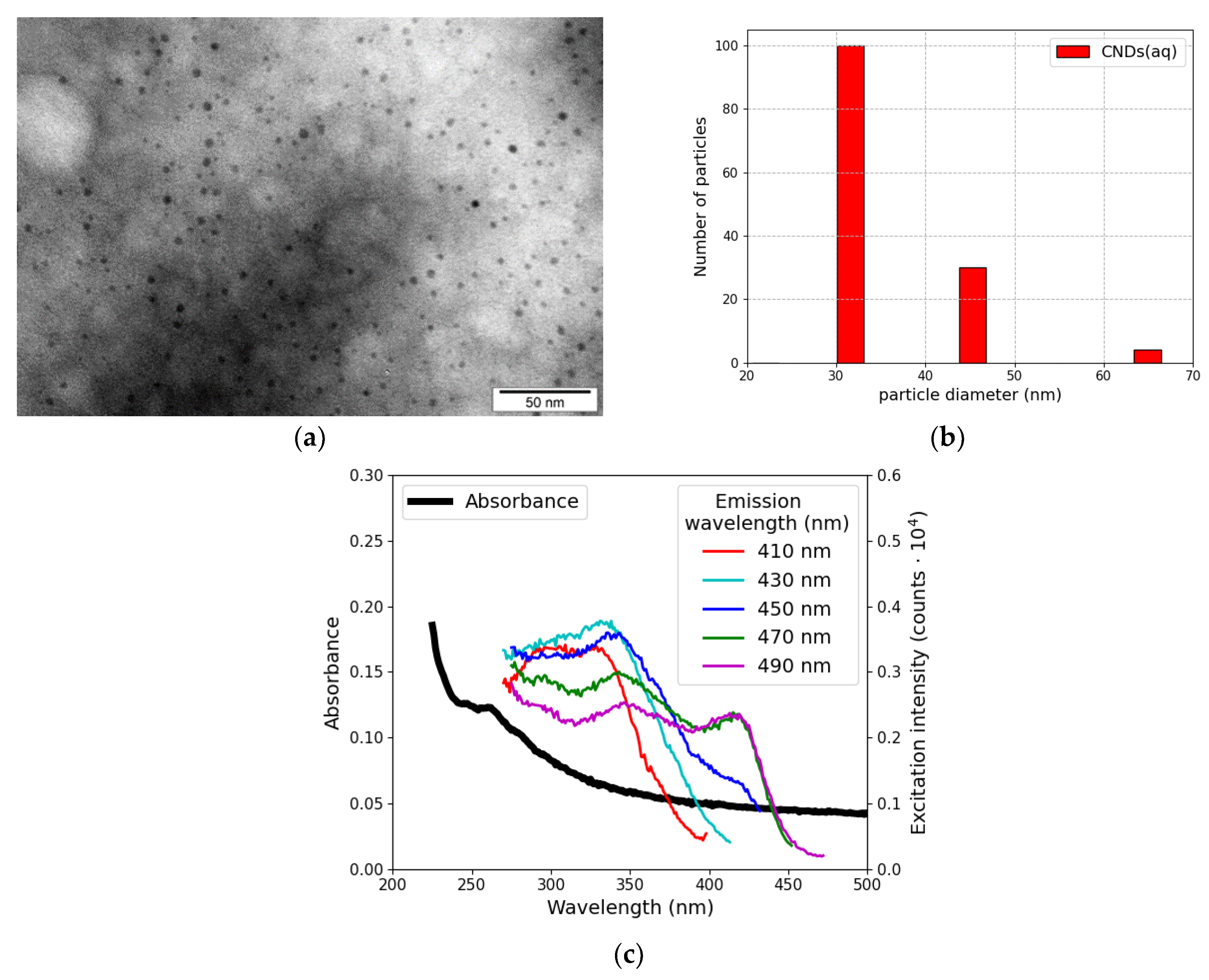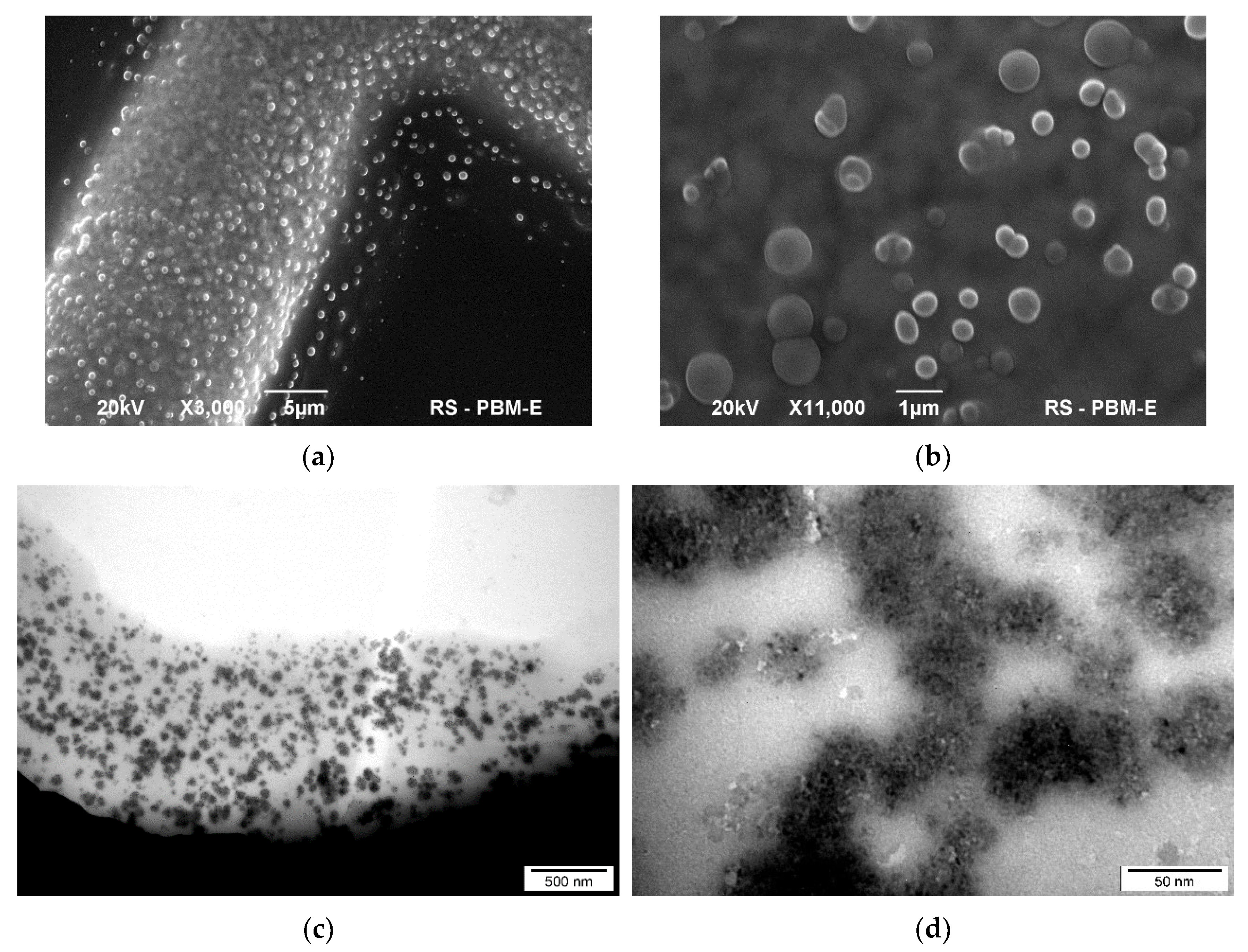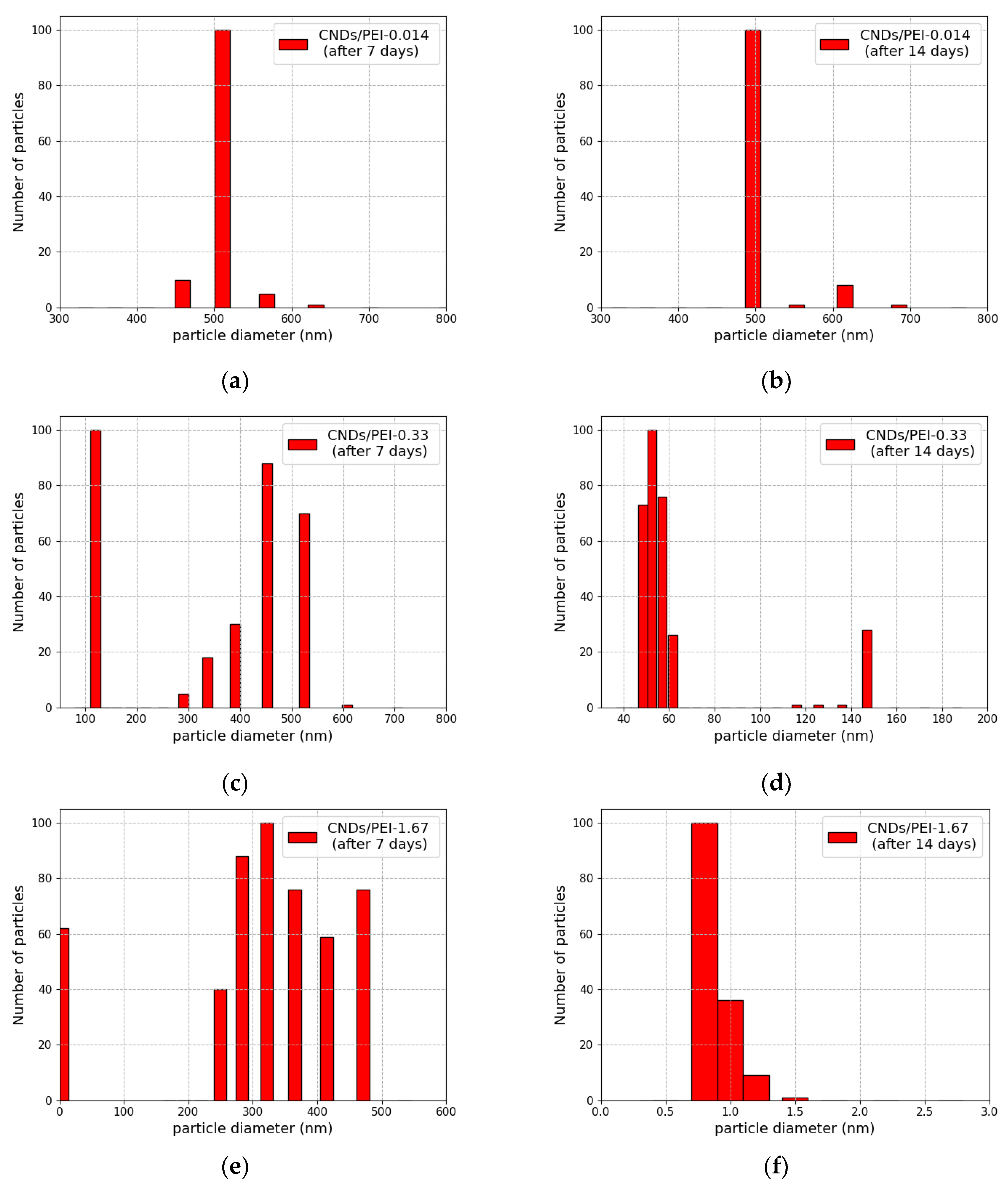The Luminescence of Laser-Produced Carbon Nanodots: The Effect of Aggregation in PEI Solution
Abstract
1. Introduction
- -
- Core emission, determined by its degree of crystallinity and attributed to the π–π* transitions of the C=C bonds;
- -
- Surface states, related to the presence of functional groups connected to the carbon core;
- -
- Molecular states, where emission originates from free or bounded fluorescent molecules and is dramatically influenced by the nature (properties) of these luminophores.
- -
2. Experimental Procedures
2.1. Reagents and Materials
2.2. Synthesis of Carbon Nanodots in Water
2.3. Modification (Functionalization) of CNDs(aq)
2.4. Characterization Methods
3. Results and Discussion
3.1. Characterization of Pristine Aqueous CNDs
3.2. Characterization of CND/PEI Systems
3.3. Adsorption Kinetic Study
4. Conclusions
Author Contributions
Funding
Institutional Review Board Statement
Informed Consent Statement
Data Availability Statement
Conflicts of Interest
References
- Wang, B.; Lu, S. The light of carbon dots: From mechanism to applications. Matter 2022, 5, 110–149. [Google Scholar] [CrossRef]
- Carbonaro, C.M.; Corpino, R.; Salis, M.; Mocci, F.; Thakkar, S.V.; Olla, C.; Ricci, P.C. On the Emission Properties of Carbon Dots: Reviewing Data and Discussing Models. Carbon 2019, 5, 60. [Google Scholar] [CrossRef]
- Langer, M.; Paloncýová, M.; Medveď, M.; Pykal, M.; Nachtigallová, D.; Shi, B.; Aquino, A.J.A.; Lischka, H.; Otyepka, M. Progress and challenges in understanding of photoluminescence properties of carbon dots based on theoretical computations. Appl. Mater. Today 2021, 22, 100924. [Google Scholar] [CrossRef]
- Macairan, J.-R.; de Medeiros, T.V.; Gazzetto, M.; Villanueva, F.Y.; Cannizzo, A.; Naccache, R. Elucidating the mechanism of dual-fluorescence in carbon dots. J. Colloid Interface Sci. 2022, 606, 67–76. [Google Scholar] [CrossRef] [PubMed]
- Liu, Z.X.; Wu, Z.L.; Gao, M.X.; Liu, H.; Huang, C.Z. Carbon dots with aggregation induced emission enhancement for visual permittivity detection. Chem. Commun. 2016, 52, 2063–2066. [Google Scholar] [CrossRef] [PubMed]
- Arshad, F.; Ayan, P.; Sk, M.P. Review—Aggregation-Induced Emission in Carbon Dots for Potential Applications. ECS J. Solid State Sci. 2021, 10, 021001. [Google Scholar] [CrossRef]
- Chen, B.B.; Li, R.S.; Liu, M.L.; Zhang, H.Z.; Huang, C.Z. Self-exothermic reaction prompted synthesis of single-layered graphene quantum dots at room temperature. Chem. Commun. 2017, 53, 4958–4961. [Google Scholar] [CrossRef] [PubMed]
- Lim, S.Y.; Shena, W.; Gao, Z. Carbon quantum dots and their applications. Chem. Soc. Rev. 2015, 44, 362–381. [Google Scholar] [CrossRef] [PubMed]
- van Dam, B.; Nie, H.; Ju, B.; Marino, E.; Paulusse, J.M.J.; Schall, P.; Li, M.; Dohnalová, K. Excitation-Dependent Photoluminescence from Single-Carbon Dots. Small 2017, 13, 1702098. [Google Scholar] [CrossRef]
- Kaczmarek, A.; Hoffman, J.; Morgiel, J.; Mościcki, T.; Stobiński, L.; Szymański, Z.; Małolepszy, A. Luminescent carbon dots synthesized by the laser ablation of graphite in polyethylenimine and ethylenediamine. Materials 2021, 14, 729. [Google Scholar] [CrossRef]
- Kazaryan, S.A.; Starodubtsev, N.F. Study of the Optical and Luminescent Properties of Carbon Nanoparticles Using the Microphotoluminescence Method. Inorg. Mater. Appl. Res. 2020, 11, 243–256. [Google Scholar] [CrossRef]
- Zhu, S.; Song, Y.; Zhao, X.; Shao, J.; Zhang, J.; Yang, B. The photoluminescence mechanism in carbon dots (graphene quantum dots, carbon nanodots, and polymer dots): Current state and future perspective. Nano Res. 2015, 8, 355–381. [Google Scholar] [CrossRef]
- Vibhute, A.; Patil, T.; Gambhir, R.; Tiwari, A.P. Fluorescent carbon quantum dots: Synthesis methods, functionalization and biomedical applications. Appl. Surf. Sci. Adv. 2022, 11, 100311–100327. [Google Scholar] [CrossRef]
- Liu, H.; Zhao, X.; Wang, F.; Wang, Y.; Guo, L.; Mei, J.; Tian, C.; Yang, X.; Zhao, D. High-Efficient Excitation-Independent Blue Luminescent Carbon Dots. Nanoscale Res. Lett. 2017, 12, 399. [Google Scholar] [CrossRef]
- Nguyen, K.G.; Baragau, I.-A.; Gromicova, R.; Nicolaev, A.; Thomson, S.A.J.; Rennie, A.; Power, N.P.; Sajjad, M.T.; Kellici, S. Investigating the effect of N-doping on carbon quantum dots structure, optical properties and metal ion screening. Sci. Rep. 2022, 12, 13806. [Google Scholar] [CrossRef]
- Yoo, S.; Song, Y.; Hahn, S. Ultralong persistent luminescence from carbon dots. Light Sci. Appl. 2022, 11, 132. [Google Scholar] [CrossRef]
- Song, Y.; Zhu, S.; Zhang, S.; Fu, Y.; Wang, L.; Zhao, X.; Yang, B. Investigation from chemical structure to photoluminescent mechanism: A type of carbon dots from the pyrolysis of citric acid and an amine. J. Mater. Chem. C 2015, 3, 5976–5984. [Google Scholar] [CrossRef]
- Kaczmarek, A.; Denis, P.; Krajewski, M.; Mościcki, T.; Małolepszy, A.; Hoffman, J. Improved laser ablation method for the production of luminescent carbon particles in liquids. Materials 2021, 14, 2365. [Google Scholar] [CrossRef]
- Shi, L.; Yang, J.; Zeng, H.; Chen, Y.; Yang, S.; Wu, C.; Zeng, H.; Yoshihito, O.; Zhang, Q. Carbon dots with high fluorescence quantum yield: The fluorescence originates from organic fluorophores. Nanoscale 2016, 8, 14374–14378. [Google Scholar] [CrossRef]
- Sciortino, A.; Cayuela, A.; Soriano, M.L.; Gelardi, F.M.; Cannas, M.; Valcárcel, M.; Messina, F. Different natures of surface electronic transitions of carbon nanoparticles. Phys. Chem. Chem. Phys. 2017, 19, 22670–22677. [Google Scholar] [CrossRef]
- Zhu, S.; Wang, L.; Zhou, N.; Zhao, X.; Song, Y.; Maharjan, S.; Zhang, J.; Lu, L.; Wang, H.; Yang, B. The crosslink enhanced emission (CEE) in non-conjugated polymer dots: From the photoluminescence mechanism to the cellular uptake mechanism and internalization. Chem. Commun. 2014, 50, 13845–13848. [Google Scholar] [CrossRef]
- Khodadust, R.; Unal, O.; Acar, H.Y. Theranostic potential of self-luminescent branched polyethyleneimine-coated superparamagnetic iron oxide nanoparticles. Beilstein J. Nanotechnol. 2022, 13, 82–95. [Google Scholar] [CrossRef]
- Boussif, O.; Lezoualc’h, F.; Zanta, M.A.; Mergny, M.D.; Scherman, D.; Demeneix, B.; Behr, J.P. A versatile vector for gene and oligonucleotide transfer into cells in culture and in vivo: Polyethylenimine. Proc. Natl. Acad. Sci. USA 1995, 92, 7297–7301. [Google Scholar] [CrossRef]
- Cheng, C.; Xing, M.; Wu, Q. Green synthesis of fluorescent carbon dots/hydrogel nanocomposite with stable Fe3+ sensing capability. J. Alloys Compd. 2019, 790, 221–227. [Google Scholar] [CrossRef]
- Hao, A.; Guo, X.; Wu, Q.; Sun, Y.; Cong, C.; Liu, W. Exploring the interactions between polyethyleneimine modified fluorescent carbon dots and bovine serum albumin by spectroscopic methods. J. Lumin. 2016, 170, 90–96. [Google Scholar] [CrossRef]
- Yuan, W.Z.; Zhang, Y. Nonconventional Macromolecular Luminogens with Aggregation-Induced Emission Characteristics. J. Polym. Sci. Pol. Chem. 2017, 55, 560–574. [Google Scholar] [CrossRef]
- Zhang, H.; Zhao, Z.; McGonigal, P.R.; Ye, R.; Liu, S.; Lam, J.W.Y.; Kwok, R.T.K.; Zhang, Y.W.; Xie, J.; Rogach, A.L.; et al. Clusterization-triggered emission: Uncommon luminescence from common materials. Mater. Today 2020, 32, 275–292. [Google Scholar] [CrossRef]
- Tóth, V.; Hermann, P.; Végh, D.; Zelles, T.; Géczi, Z. Study of the Intrinsic Fluorescence of a Highly Branched Cationic Dendrimer, Poly(Ethyleneimine) (PEI). Molecules 2019, 24, 3690. [Google Scholar] [CrossRef]
- Kaczmarek, A.; Hoffman, J. The best conditions for the nucleation of carbon nanoparticles in laser-induced plasma. Nanotechnology 2022, 33, 355602. [Google Scholar] [CrossRef]
- Zheng, T.; Bott, S.; Huo, Q. Techniques for Accurate Sizing of Gold Nanoparticles Using Dynamic Light Scattering with Particular Application to Chemical and Biological Sensing Based on Aggregate Formation. ACS Appl. Mater. Interfaces 2016, 8, 21585–21594. [Google Scholar] [CrossRef]
- Hoogeveen, N.G.; Cohen Stuart, M.A.; Fleer, G.J. Can charged (block co)polymers act as stabilisers and flocculants of oxides? Colloid Surf. A 1996, 117, 77–88. [Google Scholar] [CrossRef]
- Ren, T.-B.; Xu, W.; Zhang, W.; Zhang, X.-X.; Wang, Z.-Y.; Xiang, Z.; Yuan, L.; Zhang, X. A General Method To Increase Stokes Shift by Introducing Alternating Vibronic Structures. J. Am. Chem. Soc. 2018, 140, 7716–7722. [Google Scholar] [CrossRef]
- Valeur, B.; Berberan-Santos, M.N. Molecular Fluorescence: Principles and Applications, 2nd ed.; Wiley-VCH: Hoboken, NJ, USA, 2012. [Google Scholar]
- Maruthapandi, M.; Kumar, V.; Luong, J.H.T.; Gedanken, A. Kinetics, Isotherm, and Thermodynamic Studies of Methylene Blue Adsorption on Polyaniline and Polypyrrole Macro-Nanoparticles Synthesized by C-Dot-Initiated Polymerization. ACS Omega 2018, 3, 7196–7203. [Google Scholar] [CrossRef]
- El-Sharkawy, R.; El-Ghamry, H.A. Multi-walled carbon nanotubes decorated with Cu(II) triazole Schiff base complex for adsorptive removal of synthetic dyes. J. Mol. Liq. 2019, 282, 515–526. [Google Scholar] [CrossRef]
- Sabzehmeidani, M.M.; Mahnaee, S.; Ghaedi, M.; Heidari, H.; Roy, V.A. Carbon based materials: A review of adsorbents for inorganic and organic compounds. Mater. Adv. 2021, 2, 598–627. [Google Scholar] [CrossRef]
- Kostoglou, M.; Karapantsios, T.D. Why Is the Linearized Form of Pseudo-Second Order Adsorption Kinetic Model So Successful in Fitting Batch Adsorption Experimental Data? Colloids Interfaces 2022, 6, 55. [Google Scholar] [CrossRef]
- Nowicki, W.; Nowicka, G. Adsorption of large macromolecules on fine colloidal particles. Colloid Polym. Sci. 1995, 273, 473–479. [Google Scholar] [CrossRef]
- Mun, E.A.; Hannell, C.; Rogers, S.E.; Hole, P.; Williams, A.C.; Khutoryanskiy, V.V. On the Role of Specific Interactions in the Diffusion of Nanoparticles in Aqueous Polymer Solutions. Langmuir 2014, 30, 308–317. [Google Scholar] [CrossRef]
- Catipovic, M.A.; Tyler, P.M.; Trapani, J.G.; Carter, R. Improving the quantification of Brownian motion. Am. J. Phys. 2013, 81, 485–491. [Google Scholar] [CrossRef]






| Sample Name | Mixture Composition | Concentration of PEI in the Mixture (% v/v) |
|---|---|---|
| CNDs(aq) | - | 0 |
| CND/PEI-0.014 | CNDs(aq) + PEI0.25 | 0.014 |
| CND/PEI-0.33 | CNDs(aq) + PEI2 | 0.33 |
| CND/PEI-1.67 | CNDs(aq) + PEI10 | 1.67 |
| Sample | Maximum Band Position (nm) | Stokes Shift (nm) [31] | |
|---|---|---|---|
| Absorbance | Emission | ||
| CNDs(aq) | 260 | 430 | 170 |
| CND/PEI-0.014 | 325 | 470 | 145 |
| CND/PEI-0.33 | 340 | 430 | 90 |
| CND/PEI-1.67 | 340 | 430 | 90 |
| PEI Content in the Sample (%) | Calculated Diffusion Rate Constant | Diffusion Rate Ratio | |
|---|---|---|---|
| First Stage | Second Stage | ||
| 0.014 | 1.33 | 0.19 | 7.00 |
| 0.33 | 1.17 | 0.14 | 8.36 |
| 1.67 | 1.13 | 0.18 | 6.28 |
| Particle Size (nm) | Diffusion Coefficient | (mm) within 24 h |
|---|---|---|
| 5 | 9812 | 4.12 |
| 10 | 4906 | 2.91 |
| 30 | 1635 | 1.68 |
| 50 | 981 | 1.30 |
| 100 | 490 | 0.92 |
| 200 | 245 | 0.65 |
Disclaimer/Publisher’s Note: The statements, opinions and data contained in all publications are solely those of the individual author(s) and contributor(s) and not of MDPI and/or the editor(s). MDPI and/or the editor(s) disclaim responsibility for any injury to people or property resulting from any ideas, methods, instructions or products referred to in the content. |
© 2024 by the authors. Licensee MDPI, Basel, Switzerland. This article is an open access article distributed under the terms and conditions of the Creative Commons Attribution (CC BY) license (https://creativecommons.org/licenses/by/4.0/).
Share and Cite
Kaczmarek, A.; Wisniewska, A.; Mościcki, T.; Hoffman, J. The Luminescence of Laser-Produced Carbon Nanodots: The Effect of Aggregation in PEI Solution. Materials 2024, 17, 1573. https://doi.org/10.3390/ma17071573
Kaczmarek A, Wisniewska A, Mościcki T, Hoffman J. The Luminescence of Laser-Produced Carbon Nanodots: The Effect of Aggregation in PEI Solution. Materials. 2024; 17(7):1573. https://doi.org/10.3390/ma17071573
Chicago/Turabian StyleKaczmarek, Agata, Agnieszka Wisniewska, Tomasz Mościcki, and Jacek Hoffman. 2024. "The Luminescence of Laser-Produced Carbon Nanodots: The Effect of Aggregation in PEI Solution" Materials 17, no. 7: 1573. https://doi.org/10.3390/ma17071573
APA StyleKaczmarek, A., Wisniewska, A., Mościcki, T., & Hoffman, J. (2024). The Luminescence of Laser-Produced Carbon Nanodots: The Effect of Aggregation in PEI Solution. Materials, 17(7), 1573. https://doi.org/10.3390/ma17071573








